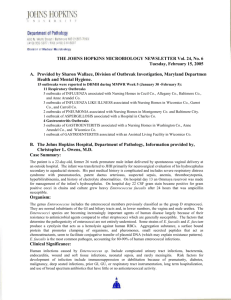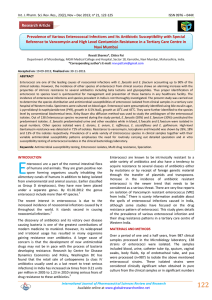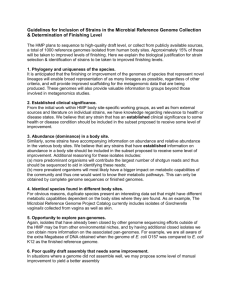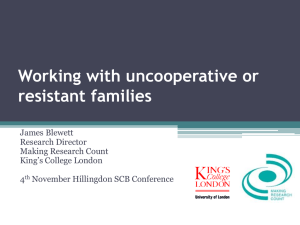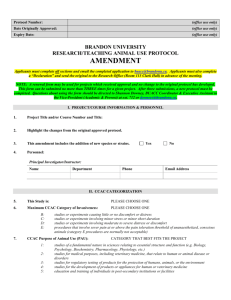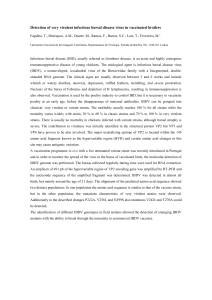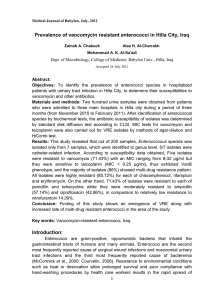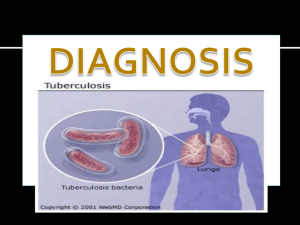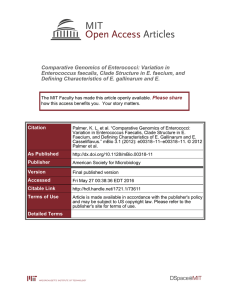Enterococcus - Broad Institute
advertisement
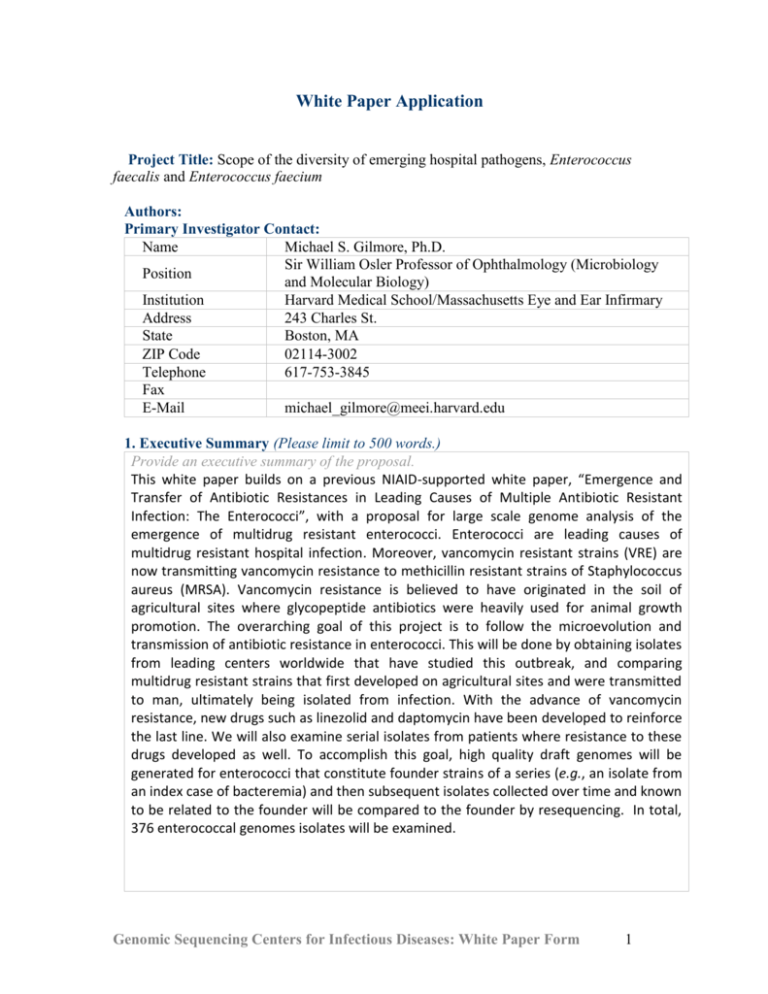
White Paper Application Project Title: Scope of the diversity of emerging hospital pathogens, Enterococcus faecalis and Enterococcus faecium Authors: Primary Investigator Contact: Name Michael S. Gilmore, Ph.D. Sir William Osler Professor of Ophthalmology (Microbiology Position and Molecular Biology) Institution Harvard Medical School/Massachusetts Eye and Ear Infirmary Address 243 Charles St. State Boston, MA ZIP Code 02114-3002 Telephone 617-753-3845 Fax E-Mail michael_gilmore@meei.harvard.edu 1. Executive Summary (Please limit to 500 words.) Provide an executive summary of the proposal. This white paper builds on a previous NIAID-supported white paper, “Emergence and Transfer of Antibiotic Resistances in Leading Causes of Multiple Antibiotic Resistant Infection: The Enterococci”, with a proposal for large scale genome analysis of the emergence of multidrug resistant enterococci. Enterococci are leading causes of multidrug resistant hospital infection. Moreover, vancomycin resistant strains (VRE) are now transmitting vancomycin resistance to methicillin resistant strains of Staphylococcus aureus (MRSA). Vancomycin resistance is believed to have originated in the soil of agricultural sites where glycopeptide antibiotics were heavily used for animal growth promotion. The overarching goal of this project is to follow the microevolution and transmission of antibiotic resistance in enterococci. This will be done by obtaining isolates from leading centers worldwide that have studied this outbreak, and comparing multidrug resistant strains that first developed on agricultural sites and were transmitted to man, ultimately being isolated from infection. With the advance of vancomycin resistance, new drugs such as linezolid and daptomycin have been developed to reinforce the last line. We will also examine serial isolates from patients where resistance to these drugs developed as well. To accomplish this goal, high quality draft genomes will be generated for enterococci that constitute founder strains of a series (e.g., an isolate from an index case of bacteremia) and then subsequent isolates collected over time and known to be related to the founder will be compared to the founder by resequencing. In total, 376 enterococcal genomes isolates will be examined. Genomic Sequencing Centers for Infectious Diseases: White Paper Form 1 2. Justification Enterococci have emerged as leading causes of multidrug resistant hospital infection. In the 1980’s, strains emerged that, in addition to other antibiotics, were also resistant to the last line drug vancomycin. Vancomycin resistant enterococci (VRE), now constitute over 30% of enterococcal isolates at most major healthcare centers. Compounding the concern of untreatable enterococcal infection, VRE are now transmitting vancomycin resistant to methicillin resistant Staphylococcus aureus (MRSA) as well. In an effort to understand how multidrug resistant, hospital pathogen strains of enterococci emerged from otherwise benign gut commensals, we collaborated with the Broad Institute to compare the genomes of strains of the leading causes of multidrug resistant enterococcal infection, E. faecalis, E. faecium, E. casseliflavus and E. gallinarum. That comparison provided information that served as a springboard for determining that a key genetic event in the evolution of multidrug resistant enterococci was the loss of CRISPR defense of the chromosome. This appears to have opened the genus to entry of many mobile genetic elements, including pathogenicity islands, phage, transposons and plasmids. Although the above study provided a genetic mechanism for the facile acquisition of traits that led to the rapid evolution of multidrug resistant hospital pathogens, how enterococci transition from being highly successful members of the complex GI tract consortium of man and animals, to being efficient survivors of the hospital environment, and effective persisters in the bloodstream and other tissues of hospitalized patients remains largely unknown. Collection of enterococci exist that include isolates from the GI tracts of animals on an agricultural site, the same isolate from the GI tract of man living in the same environment, and the bloodstream of patients from that region. Other strain collections include isolates from the blood stream of a series of patients that were hospitalized in a ward of a major care center for over 3 years. Still other isolate collections include strains originally isolated from a patient’s GI tract, and then subsequently isolated from the bloodstream, and still later, what appears to be the same strain isolated from the same patients bloodstream after developing resistance to a newly introduced antibiotic. The advent of next generation sequencing, and a solid established base of sequence data, now makes possible the rapid comparison of whole genome sequences to determine how enterococci adapt in transitioning from colonizers of the GI tracts of animals and man, to successful pathogens becoming endemic in hospital wards and causing many bloodstream infections over protracted periods. These comparisons will identify the lynchpin in the process, revealing which conversions at the DNA level are essential to the success of enterococci as hospital pathogens. Our goal, therefore, is to obtain high quality draft sequence for 400 strains derived from closely-related sets of strains, as determined by pulse field gel or multilocus sequencing typing, that include isolates from various points in the evolution of virulent, multidrug resistant lineages. These strains come from collections and collaborators worldwide. Genomic Sequencing Centers for Infectious Diseases: White Paper Form 2 3. Rationale for Strain Selection Vancomycin resistance in enterococci is believed to have originated in Northern Europe in response to the widespread use of glycopeptides antibiotics as growth promoters. The initial cases of vancomycin resistant enterococcal infections were reported nearly simultaneously in France and in England in the mid 1980’s. By the mid 1990’s, the association between agricultural use and the emergence of antibiotic resistance became generally accepted, and some countries took action, including establishing national centers for surveillance and tracking of the emergence of multidrug resistant enterococci. Two of the most active groups in this regard are in Denmark and The Netherlands, both of which boast leading scientists and excellent, well characterized collections of enterococci related to resistance outbreaks on farm and in hospital settings. In the early 1990’s, an outbreak of multidrug resistant enterococcal bacteremia occurred in the University of Wisconsin Hospitals and Clinics and 209 enterococcal isolates were obtained. One clone was found to account for as many as 62 of the isolates, and representatives of this clone were isolated from multiple patients over a period of 17 months. More recently, patients have been treated with new, last line drugs including linezolid and vancomycin. Because of concern for the development of enterococcal infection, particularly in cancer and transplant patients, select academic centers follow immune compromised patients closely by examining possible fecal carriage of multidrug resistant enterococci. In some cases, those same strains have emerged in the bloodstream of patients, and following treatment with linezolid or daptomycin, have emerged as resistant. We have several series of such strains obtained from Sloan Kettering and Cubist Pharmaceuticals, that will be included in these studies. Leaders from around the world who have studied the emergence of antibiotic resistance in enterococci contributed strains from their collections for this project, and will be included in the data analysis. In collaboration with many different groups (indicated in parentheses), strains have been selected to address the following areas in enterococcal research (for more detailed strain information, see appendix 1): 1) Comparison of related isolates recovered from different animal host reservoirs (Jensen/Hammerum): 35 E. faecium, 19 E. faecalis 2) Isolate that has been able to colonize and transfer resistance genes in the intestine of healthy humans (Jensen/Hammerum): 1 E. faecium 3) Strains isolated from poultry and farmers (Jensen/Hammerum): 2 E. faecium 4) Atypical linkage between ermB and vatE (Jensen/Hammerum): 1 E. faecium 5) Related isolates collected in an outbreak of enterococcal bacteremia over 17 months (Huycke): 66 E. faecalis 6) Evolution of daptomycin and linezolid resistance during patient treatment (Pamer): 10 E. faecium 7) Diversity of the species "faecium," including isolates from the preantibiotic era (Willems/van Schaik): 53 E. faecium 8) E. faecium ST78 epidemic "clone" circulating in Europe and Asia from different geographies (Willems/van Schaik): 10 E. faecium 9) Evolution of E. faecalis clonal lineages from different locations and times Genomic Sequencing Centers for Infectious Diseases: White Paper Form 3 (Gilmore): 68 E. faecalis 10) Completion of the diversity of E. faecalis unique MLST lineages (Gilmore): 28 E. faecalis 11) First appearance of VanA E. faecium in US farm animals (Donabedian): 6 E. faecium (all VanR) 12) Gentamicin-resistant Enterococcus faecalis sequence type 1 6 with reduced penicillin susceptibility (Jensen): 20 E. faecalis 13) Emergence and evolution of vancomycin resistance in Europe 1986 - 2010 (Courvalin): 17 E. faecalis, 42 E. faecium 4a. Approach to Data Production: Data Generation Since we wish to identify the gain of genetic elements that are associated with antibiotic resistance and host adaptation, we will generate draft de novo genome sequences for all proposed strains using the Illumina platform. Many of these genetic elements contain multiple repetitive regions, such as transposable elements, making assembly and localization of these genes difficult. To overcome this problem, we will use large jumping library insert sizes (~3-7 kb) which will enable us to scaffold over the repeated elements. 4b. Approach to Data Production: Data Analysis During the antibiotic era, enterococci have evolved from commensal organisms of the gastrointestinal tract of humans and other animals, to a leading cause of multidrug resistant hospital infection. With this large and diverse collection of antibiotic resistant enterococcal strains we will ask a number of key questions that will reveal how 1) antibiotic resistance, and in particular vancomycin resistance was spread from its origins in Europe to the US and other geographic sites, 2) drug resistant strains evolved in these various locales by comparing serial isolates from separate centers, and 3) enterococci adapt to various niches by comparing nearly identical strains isolated from the faeces of farm animals, humans, than human infections. We will examine the relatedness and evolution of isolates, and correlate that with information about the genesis of those strains. Specifically, divergence will be examined using approaches such as generation of a single-copy core tree and 4-site saturation. As an isolate evolved to inhabit new niches (e.g., animal fecal, to human fecal, to human bloodstream) metabolic differences may be reflected in genetic changes. Analysis of rapid areas of genome drift (e.g., Genomic Sequencing Centers for Infectious Diseases: White Paper Form 4 surface proteins, metabolic pathways related to a shift in available nutrients) will be examined by examining the dN/dS, the ratio of the rate of non-synonymous substitutions to the rate of synonymous substitutions, as an indicator of selective pressure acting on a protein-coding gene. As lineages become adapted to new niches (e.g., hospitals) we will examine genomes for orphan genes as well as acquisition of new elements (plasmids, pathogenicity islands, phage). 5. Community Support and Collaborator Roles: We launched the ASM conference series “International ASM Conference on Enterococci” in 2000 in Banff, Canada to bring cohesion to the field and international focus to the emerging problem of multidrug resistant enterococci. Since then, we have held meetings in 2005 in Helsingor, Denmark, and in 2010 in Portland. The present genome initiative involves organizers from all 3 conferences, each of which was attended by an average of 200 scientists from across the globe. Collaborators on the current project include: Organizer: Michael S. Gilmore, Ph.D., Harvard Medical School, Boston MA Contributors and external members of the analysis team: Lars B. Jensen, Ph.D., Associate professor, Danish Technical University, National Food Institute Division of Microbiology and Risk Assessment Annette Hammerum, Head, Antimicrobial Resistance Reference Laboratory and Surveillance Unit, Department of Microbiological Surveillance and Research, Statens Serum Institut, Copenhagen, Denmark Patrice Courvalin, MD, Professor, Pasteur Institute, Paris France Yasu Ike, MD, Department of Microbiology, Laboratory of Bacterial Drug Resistance, Gunma University School of Medicine, Division of Microbiology, Clinical Laboratory, Medical School Hospital, Maebashi, Gunma 371-8511, Japan Rob J.L. Willems, Ph.D., Associate Professor, Department of Medical Microbiology, University Medical Center Utrecht, The Netherlands Willem van Schaik, PhD, Assistant Professor, Dept. of Medical Microbiology, University Medical Center Utrecht, The Netherlands Susan M. Donabedian, Ph.D., Research Associate, Division of Infectious Diseases, Henry Ford Hospital, Detroit Marcus J. Zervos, MD, Chief of Infectious Diseases, Henry Ford Hospital, Detroit Eric G. Pamer, MD Chief, Infectious Diseases Service; Enid A. Haupt Chair in Clinical Investigation, Memorial Sloan Kettering, New York Mark M. Huycke, MD, Francis Duffy Professor and Chief of Staff, VA Medical Center, Oklahoma City, OK Lynn E. Hancock, Ph.D., Assistant Professor, Division of Biology, Kansas State University Nathan Shankar, Ph.D., Professor and Vice Chair, Medicinal Chemistry, University of Oklahoma Health Sciences Center Jarred Silverman, PhD, Chief of In Vitro Development, Cubist Pharmaceuticals, Inc. Genomic Sequencing Centers for Infectious Diseases: White Paper Form 5 The organizer and external members of the analysis team will work with the Broad scientists to review the data and annotation as it is assembled for congruence with what is known about the genus Enterococcus, then will work with the Broad bioinformatics staff to stratify the data and make meaningful comparisons based on the biology of enterococci and pathogenesis of infection. Additional members of the team may be added during the course of the work with the general agreement of the current membership. The Gilmore lab will supply high quality total DNA from each of the strains using resources from independently funded projects. 6. Availability & Information of Strains: All strains to be analyzed are from existing collections, and are currently being gathered in the Gilmore Lab, Boston, MA. Because of the number of strains, they are listed in the attached spreadsheet along with supporting data. Each has been published, occurs in a national, publicly available collection, or was collected with local Institutional Review Board Approval. Publications referencing the strains and supporting information are indicated in the attached spread sheet. Genomic DNA will be prepared according to GSC recommendations for preparation. Genomic Sequencing Centers for Infectious Diseases: White Paper Form 6 7. Compliance Requirements: 7a. Review NIAID’s Reagent, Data & Software Release Policy: NIAID supports rapid data and reagent release to the scientific community for all sequencing and genotyping projects funded by NIAID GSC. It is expected that projects will adhere to the data and reagent release policy described in the following web sites. http://www3.niaid.nih.gov/research/resources/mscs/data.htm http://grants.nih.gov/grants/guide/notice-files/NOT-OD-08-013.html <Each Center to include their website that describes/points to the guidelines> Once a white paper project is approved, NIAID GSC will develop with the collaborators a detailed data and reagent release plan to be reviewed and approved by NIAID. Accept X Decline 7b. Public Access to Reagents, Data, Software and Other Materials: 1. State plans for deposit of starting materials as well as resulting reagents, resources, and datasets in NIAID approved repositories. Sequencing projects will not begin until the strain is deposited into NIAID funded BEI repository (http://www.beiresources.org/). This includes web based forms are completed by the collaborator and received by the NIAID BEI (http://www.beiresources.org/). The strains will be deposited in BEI repository in conjunction with the sequencing project and relevant clinical information and literature citations will be made available. Relevant metadata will be released to NCBI (see appendix for sample fields) 7c. Research Compliance Requirements Upon project approval, NIAID review of relevant IRB/IACUC documentation is required prior to commencement of work. Please contact the GSC Principal Investigator(s) to ensure necessary documentation are filed for / made available for timely start of the project. Investigator Signature: Investigator Name: Date: Genomic Sequencing Centers for Infectious Diseases: White Paper Form 7 Blank Last Page 8
